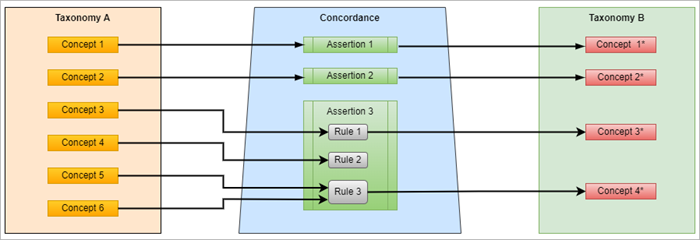Record concordance between taxonomies
A concordance is a means for mapping sustainability data from one taxonomy against similar data in another taxonomy.
Sometimes a data preparer or data consumer needs to compare data reported against different standards or different versions of the same standard, for example:
- Existing sustainability data prepared against one standard needs to be reported using a new standard.
- Sustainability data must be reported against several standards using different taxonomies.
- Sustainability data needs to be compared against reports that use previous versions of the same taxonomy.
- A user wants to create a Business Information (BI) dashboard that compares results from more than one standard.
A concordance document created by a regulator or other Non-Governmental Organisation (NGO) is used by data preparers and data consumers for transforming the data reported against one standard to usable data in a different standard. A concordance defined by a regulator or other NGO avoids each data preparer and data consumer coming up with their own imperfect solution.
XBRL standard and concordances
XBRL precision when reporting data enables the concordances created by a regulator or other NGO to be accurate in their mapping of data from one taxonomy to another. XBRL has a well-structured and consistent hierarchy where data points are accurately defined. The mapped data can be exported using xBRL-JSON and is usable for analysis in BI tools.
Learn more about using xBRL-JSON
Example
A data preparer needs to report certain sustainability results in two different standards. The standard the data preparer uses to prepare their report uses Taxonomy A, and the other standard uses Taxonomy B. A concordance document created by a regulator allows the data preparer to translate sustainability data from the first standard for use in the second standard.

The concordance document uses three different assertions to translate the data.
Assertion 1
Assertion 1 is a direct translation of the Revenue concept (Concept 1) in Taxonomy A to the Revenue concept (Concept 1*) in Taxonomy B.

Assertion 2
Assertion 2 translates the GreenHouseGasEmissions concept (Concept 2) of Taxonomy A, with a Scope dimension value of 2, to the CarbonEquivalentScope2 concept (Concept 2*) of Taxonomy B.

Assertion 3
Assertion 3 is a complex assertion that translates a table of facts in Taxonomy A to a table in Taxonomy B. The assertion contains three rules to handle the translation of the concepts in the Taxonomy A table:
- Rule 1: type: qname-with-dimensions
This rule translates the NuclearEnergy concept (Concept 3) of Taxonomy A, to the EnergyUsage concept (Concept 3*) of Taxonomy B, with a Type dimension value of Nuclear. - Rule 2: type: unmapped
The GasEnergy concept (Concept 4) of Taxonomy A has no equivalent in Taxonomy B and so is not mapped. - Rule 3: type: derived
This rule sums the fact values of the EnergyUsageRenewable and EnergyUsageNonRenewable concepts (Concepts 5 and 6) of Taxonomy A, to derive the fact value for the TotalEnergyUsage concept (Concept 4*) of Taxonomy B.

More detail
Creating concordances
It is recommended that concordances are created by independent regulatory bodies with the consultation and approval of the regulators, standard setters, and technical implementers of the applicable standards. Consultation is important to maintain the interoperability of the relevant standards and to ensure that the concordance created is trustworthy and usable.